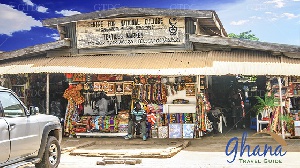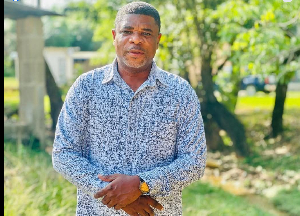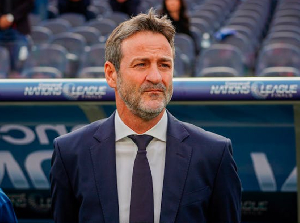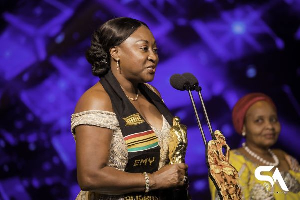A couple of weeks ago, the President, H.E. Nana Akufo-Addo made a commitment to the creative industry, a promise to build three new theatres in Kumasi, Takoradi and Tamale.
The President assured that his government is committed to building these ultra-modern theaters to promote local arts. These were his words;
“We are committed to building multi-purpose theaters in Takoradi, Kumasi and Tamale. It is sad that it has taken this long, but we should make good this serious omission in our artistic and cultural infrastructure.”
Clearly, this laudable initiative would not be realized this year because, it was not captured in the 2017 Budget, but thankfully, the President has four years with a possibility of another four years of governance, so, this promise can be fulfilled.
However, it is quite intriguing that, there are existing structures in Takoradi, Kumasi and Tamale plus other regions, which are serving the same purpose as these new theatres would but are not getting any mention.
These edifices, which were built to elevate the arts, culture and tourism while solving sensitive socio-economic problems of the State – have been in a ramshackle state for years, yet, there’s not been any assurance on their rehabilitation or otherwise.
 Art Centre
Art Centre
Existence of Centers for National Culture
There are seven (7) Centers for National Culture across the country, in Greater Accra, Ashanti Region, Volta Region, Northern Region, Western Region, Central Region and Eastern Region; all established by law, from PNDC law 238 of 1990 to Act of Parliament, 1958.
The primary aim of establishing these institutions is to preserve, protect, promote and project the rich cultural values and heritage of Ghana.
The establishment of these structures was modeled to portray the three distinctive features of our culture; history, folklore music/dance/drama and the arts & craft.
The aim is not different from the aim the President and the government has, in promising to establish three (3) new theatres.
These Centers Have Everything!
It is interesting to note that, most of these Centers encompass everything the arts or creative industry represents.
Most of these Centers have various departments that cater to Museum, Performing Arts, Visual Arts, Literary Arts, Research and Administration, among others.
The Prempeh II Jubilee Museum in the Center in Kumasi houses many valuable artifacts including the Ashanti War Drum, a photocopy of the Golden Stool and many others.
There’s room for the many drama troupes in the regions under Performing Arts Department. There’s also avenue for the many doing Broadloom Weaving, Traditional Kente Weaving, Pottery and Ceramics, Batik, Tie & Dye and Sewing,Sculpturing and Painting – all under the department of Visual Arts.
Refreshingly, there’s even supposed to be a Puppetry Section at the Central Region Center, where there’s a puppetry group that has been adopted out of the Centre’s dance company.
 Cultural Heritage, Tanzania
Cultural Heritage, Tanzania
The State of These Art Centers
International blogger, Kelly Parke, like many other foreign visitors, visited the Center for National Culture in Accra, popularly known as the ‘Arts Center’ – and wrote her experience for the website, www.africa.com.
One of her many tributes to the Center after read;
“The Accra Arts Center is not exactly a nice, big, orderly building. Rather, it is a crowded collection of vendor stalls; for first time visitors, entering the dimly lit market can be overwhelming. Vendors will do anything to lure buyers into their stalls: cajole, joke, sing, tug at sleeves… ahem, meet you at your car in the dirt parking lot and personally accompany you to their stall.”
Kelly captures the exact state of the Arts Center in Accra; not nice, not an orderly building, crowded, dimly lit and dirty parking lot. Impressive!
That is the sort of information any potential visitor to Ghana and to the Centers across the regions would get when they surf the internet to get information about structures that are supposed to sell our arts, culture and tourism.
If the Center in Accra, where the seat of Government of Ghana is also located, has such description, please, do not imagine what the other Centers in other regions would look like. Save your imagination and thoughts!
 Arts Center, Kumasi
Arts Center, Kumasi
Yes, Build The Theatres But Fix The Centers
The President, while announcing the Government’s commitment to building these new Theatres also made a poignant statement on the arts. Hear him:
“Our composers, painters, film makers, writers, musicians, sculptors, actors and actresses contribute immensely to our advancement as a nation and it is for this reason that supporting the industry that is giving the arts and culture the attention and incentives to flourish is an important focus of mine.”
Clearly, the first gentleman of the land has a good grasp on how important the creative industry is to the development of the nation. Maybe, what he does not know is that; these centers, which house most of the artisans and major players of the art – are in dilapidated state.
Those Centers provide space for many persons who look for their daily bread – a check on the canker of unemployment. These same old Centers serve as major tourist sites for the Ghana. In fact, many foreign visitors patronize the Art Centers more than the indigenes, which means, tourism is being taken care of
In essence, the Art Centers were built to solve most of our socio-economic problems, from unemployment to tourism to the curbing of rural-urban migration among others.
Building the new Theatres is not a bad investment; it would also go a long way of boosting the arts industry but the rehabilitation of the Art Centers across the seven regions in the country should be the topmost priority of the Government.
The Centers Must Be Marketed Well
The facelift of these Centers, albeit crucial, would not be complete if they are not marketed well. They must look appealing to be able to attract patronage, in order to sustain livelihood and ameliorate the economy.
All the Centers must be furnished with websites, must have strong social media presence, which will make it easier for that foreign visitor to be able to know which Center has what or which Center is showcasing what.
These Centers are directly linked with the promotion of tourism and essentially, the arts; so, the Ministry of Tourism, Arts and Culture and its Institutions; National Commission on Culture, Ghana Tourism Authority and the Ghana Tourist Development Company, must be effective in ensuring that, the Centers reach their full potential.
Entertainment of Tuesday, 4 April 2017
Source: entertainmentgh.com













